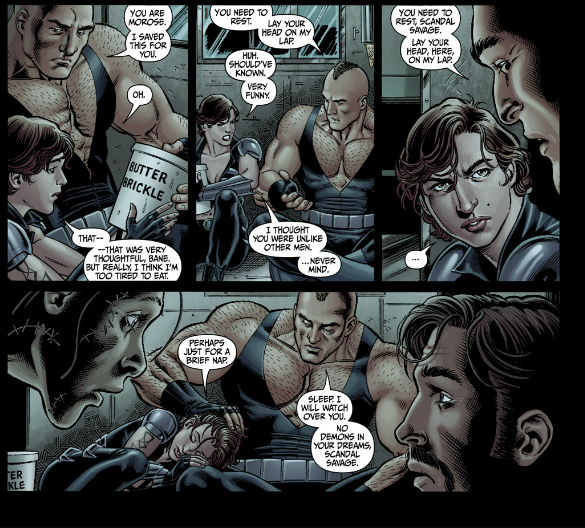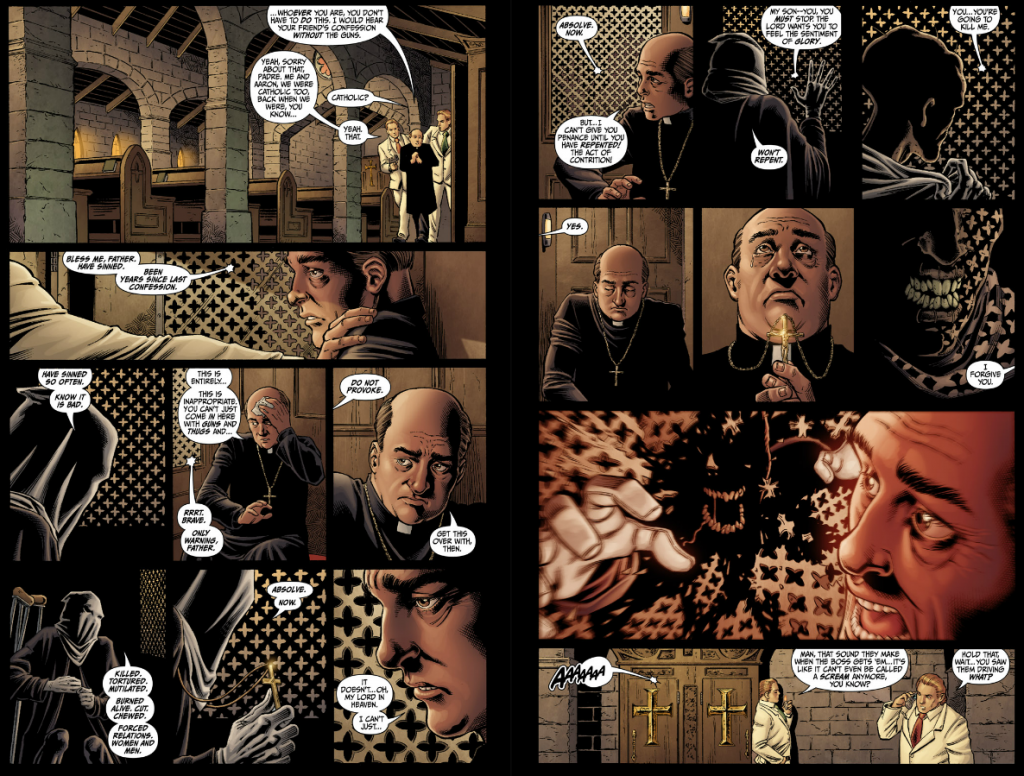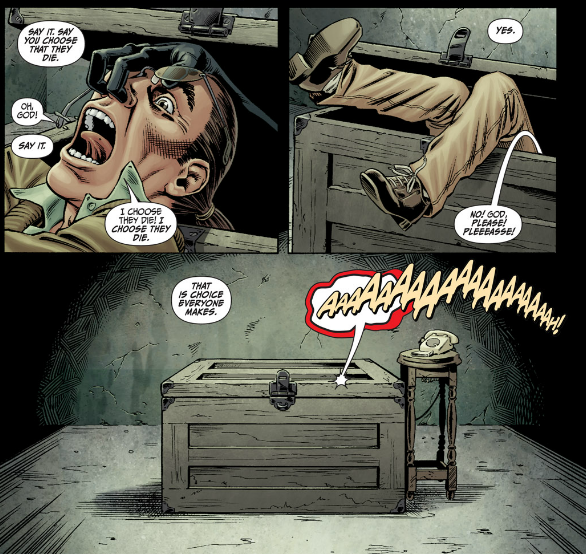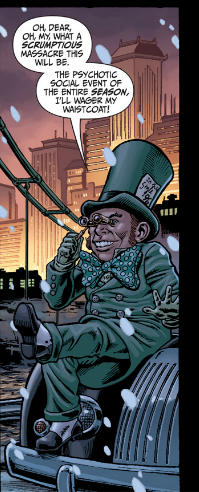I had at least a passing familiarity with nearly all of the stories chosen by Christy Blanch for her Gender in Comic Books SuperMOOC. Gail Simone’s 2008 run on Secret Six was not one of those. In fact, I hadn’t even heard of any of the main characters in Secret Six other than Deadshot and Bane; and I’d heard of Deadshot, but had no idea who he was. However, the description of the book seemed to be one of wanton violence and naughtiness since the team wasn’t made up of heroes. Here’s the high-level description: someone has hired this group of mercenaries to spring someone from prison. That person has something important within their body. Deliver that person to the person who hired the group. Also, someone else wants this object and is willing to offer millions of dollars for the death and/or capture of the Secret Six. Sounds like a fun action movie. And there’s nothing wrong with that, but you don’t exactly expect to have it challenge your notions of comic story-telling. But we’re talking Gail Simone at the peak of her talent here. The rest of this post, as most of the posts on this site, will contain significant spoilers.

The opening scene is a strange one that introduces the villain, Junior, and his henchmen who remind me a lot of Shlubb and Klump from Sin City (at least the movie version). We’ll get back to them later because I think the scene that follows is the best at setting the tone of this story arc. Catman and Deadshot have a conversation right out of Quentin Tarantino’s Pulp Fiction about getting out of the mercenary business while the do the absolutely ordinary task of buying some alcohol at a convenience store. This is coupled with the classic rookie criminals robbing the Awesome Badass Character In Civilian Clothes. This goes exactly as expected. I’m a sucker for karmic retribution, so I never tire of this trope. (Seriously, I have at least one live action version of this playing in my head, but I can’t remember what movie it’s from. Readers?)


And they were buying alcohol because they’ve got a horribly misguided plan to get Scandal Savage out of her alcohol-induced semi-coma over the death of her lover, Knockout. For someone like me who’d never heard of this book, it appears to be an in media res story, but it’s actually a continuation from Gail Simone’s 2006 run. How do they expect her to get over the death of her lover? They hire a stripper to dress up like her. It was such a weird idea I had to re-read that section three times to make sure I understood. It truly does set the stage for this arc.

It sets up the men to be the characters most concerned with emotion and feelings – leading to two of the key moments in the book. Meanwhile, the sole female is the stoic of the series (other than mourning the death of her lover – which anyone would do). Simone, by surrounding Scandal with men also changes up the usual co-ed team dynamics. Because Scandal is a lesbian (lamented by one of the characters) there is no chance of a hookup. The team members are free to act in the best interests of the team without having to worry about love or jealousy causing anyone to act irrationally. It’s quite refreshing not to have a story without sexual tension even if many writers don’t quite portray these things realistically – almost never have I seen team dynamics or cohesion fall apart because of love or sex between team members.

If we rarely see the consequences of these actions, we DO often see team hookups which leads Scandal to view Bane’s paternalistic relationship towards her with skepticism at first. While paternalistic relationships are nothing new to comics – see Batman and his Robins (sounds like a great band name) – what’s unique about Bane’s relationship with Scandal (at least within this arc) is that it takes on a nurturing role. I’d expect this from a female character and so it’s quite interesting to see it coming from Bane – one of the most masculine of Batman’s villains. In fact, of the male villains I can think of – Joker, Penguin, Two-Face, The Mad Hatter, Clayface, and Scarface – I think only Scarface could rival Bane for traditional masculinity. (And Scarface is a metaphor for a battered husband/wife relationship between Scarface and “The Dummy”) Yet here Bane is asking Scandal to just take a moment and rest her head on his lap as a parent might say to a child. Although Gail Simone doesn’t mention it within this story arc, it probably takes on extra significance to Bane since he grew up in prison without his parents. Unfortunately, due to Chekhov’s Gun, it’s pretty clear from the first moment that Bane states that he no longer uses venom, and made even clearer with each fight in which he refuses it, that he will eventually end up using the venom. Hey, everything can’t be a surprise in story-telling when I’ve been reading voraciously since I was three. Eventually you’ve seen it all. Still, Gail does make it count by having him decide to “kill” his sober self in order to save his new daughterly love during the arc’s final fight. Overall, I think the best thing it does for the character is to show that he is a formidable force without the venom. It’s a great metaphor for the drug addict who thinks he can’t contribute to society while sober until he’s finally forced to get off the drug. Of course, the part where Bane has to take it at the end kills THAT metaphor, but works great as the “parents would sacrifice anything for their kids” metaphor.
About halfway through the arc it’s revealed that the item that they must deliver to their employer and for which everyone is trying to kill them is a “Get out of Hell Free” card. Again, Gail Simone’s humor is at work here. The absurdity of an item essentially inspired by Monopoly, but which everyone is willing to kill over. The team starts falling apart once the group finds out about it. Tarantula, the person who stole it from Junior and who they broke out of prison, states this is exactly why it was made by Neron. For a bit it almost seems as though this will become the new direction the arc will go. However, the team is cynical enough and mercenary enough to put their bickering aside to get the card to their employer because they’re going to get a ton of money. DC, like Marvel, has a weird spiritual component. At times it appears, as here, that regular Christian theology is true. Other times there are various gods and demons that would negate that. Although it’s often best to just not think about it, it’s certainly somewhat central to the story here. I think the most interesting thing about the card is that it would probably lead to World War III were it to exist in our world. After all, could you take your chances – even if you didn’t believe in God? Even the atheist characters in Secret Six seem to desire the card. And would it not be amazing for the holder of the card? The freedom to do anything at all and be free of consequence in the next world. (It can seem easy to remain free of consequence in the mortal world)

The ramifications of possessing this card for a villain lead to one of the darkest bits of humor I have ever seen – the scene in which Junior, the main villain on this arc, goes to a confessional. He confesses his incredibly horrific sins and then demands to be forgiven. When the priest will not forgive him because Junior does not display contrition, Junior kills him and proclaims that his backup plan has failed. Now it is certain that he must obtain the card. I think it’s incredibly interesting that Junior is sufficiently scared of the thought of Hell to seek the card (and the backup plan), but is not scared enough by the thought of Hell to have avoided all his sins. Junior is the poster child for a true sociopath.

Of course I keep referring to Junior as him. When we first see Junior he’s in a box and appears to be some sort of demonic force that devours a man (after pulling him into the box).

We also learn that no one is allowed to look at Junior. When he later asks for some clothes, it’s made to seem as though he could be some sort of formless life-force filling the clothes. It’s not until the major reveal that we learn that not only is it a person, but it’s Rag Doll’s sister. While she’s all bendy like Rag Doll, I feel the opening scene with the box was misleading. Still, we can forgive that. The reveal is incredible as it reveals the damage of physical and sexual abuse through the visual metaphor that is possible in a comic book world. Her father abused her and so she rejected everything she associated with her attractiveness – reasoning it was to blame for her father’s appalling actions. This leads her to turn her body into a grotesque thing that no one would find attractive. However, the shame and pain remains in her insistence that no one look at her. In fact, she flies into a rage and kills her mooks for looking at her. And, of course, she has taken on a male identity by calling her underworld boss persona Junior. It’s an incredible thing that Gail Simone asks us to consider and, at least as I read it, she doesn’t take the usual path of using it to excuse this character’s behavior. She doesn’t say that she’s killed and maimed because of this and doesn’t demand anyone’s forgiveness (other than God’s so she doesn’t have to go to Hell). I’ve seen that scene a million times and it’s played out. So it’s great to see Simone avoid it.

Again we see uncharacteristic feelings from a male character as Deadshot pretends to double-cross everyone and take the card and Tarantula for himself. He’s just trying to protect his team from the insane melee that’s coming. And, since he’s alone in a car on a suicide mission with Tarantula, he gets to have the second brief sexual flirtation as Jeanette had just joined and changed the team dynamics with her heterosexuality.

After all that great storytelling we come to what I believe are the weakest parts of the story. First is the reveal that the entire scheme is a revenge plot by The Mad Hatter. While it’s a great callback to Simone’s previous run, it’s also kinda lame. His feelings were hurt so he hires them to steal the Get out of Hell Free card from Junior to make sure they are killed. It’s certainly interesting in the context of a gender class that The Mad Hatter should care about his feelings being hurt or being betrayed by fellow villains. Not exactly a traditional male feeling. But I felt that the Secret Six characters should have been smart enough not to take an assignment from an unknown boss. That NEVER goes well. Usually leads to betrayal. Not very genre-savvy of them. And the second weakest part was the Tarantula character. She was an FBI agent investigating Junior who goes into deep undercover and so the FBI prosecutes her for having gone rogue. Perhaps Gail just ran out of space to tell the story when she had seven issues for the entire arc, but it seemed flimsily thrown together. And that seemed reinforced by the fact that she’s a throwaway character. She dies to keep everyone from fighting over the card. But I can’t stay disappointed at Gail over this character, not when it led to one of my favorite jokes in the story involving how she was changed into her villain costume.
And so Gail Simone proves, quite well, that it’s entirely possible to have a comic that’s high on both violence and topics that really make you think.
[…] of sisterhood gone right. (And this may be a thread Simone likes to pull, as it was key to the Secret Six story) The women bond under hardship and end up considering each other as sisters. Together they defeat […]
[…] hour of the convention signing autographs and speaking to her fans. But after reading her first Secret Six arc and her first Red Sonja arc, I REALLY wanted to talk to her. So, I think it was quite fitting that […]